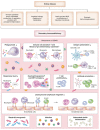Secondary Immunodeficiency Related to Kidney Disease (SIDKD)-Definition, Unmet Need, and Mechanisms
- PMID: 34907031
- PMCID: PMC8819985
- DOI: 10.1681/ASN.2021091257
Secondary Immunodeficiency Related to Kidney Disease (SIDKD)-Definition, Unmet Need, and Mechanisms
Abstract
Kidney disease is a known risk factor for poor outcomes of COVID-19 and many other serious infections. Conversely, infection is the second most common cause of death in patients with kidney disease. However, little is known about the underlying secondary immunodeficiency related to kidney disease (SIDKD). In contrast to cardiovascular disease related to kidney disease, which has triggered countless epidemiologic, clinical, and experimental research activities or interventional trials, investments in tracing, understanding, and therapeutically targeting SIDKD have been sparse. As a call for more awareness of SIDKD as an imminent unmet medical need that requires rigorous research activities at all levels, we review the epidemiology of SIDKD and the numerous aspects of the abnormal immunophenotype of patients with kidney disease. We propose a definition of SIDKD and discuss the pathogenic mechanisms of SIDKD known thus far, including more recent insights into the unexpected immunoregulatory roles of elevated levels of FGF23 and hyperuricemia and shifts in the secretome of the intestinal microbiota in kidney disease. As an ultimate goal, we should aim to develop therapeutics that can reduce mortality due to infections in patients with kidney disease by normalizing host defense to pathogens and immune responses to vaccines.
Keywords: chronic inflammation; immunodeficiency; infection; kidney disease.
Copyright © 2022 by the American Society of Nephrology.
Figures




References
-
- Seidel MG, Kindle G, Gathmann B, Quinti I, Buckland M, van Montfrans J, et al. ; ESID Registry Working Party and collaborators : The European Society for Immunodeficiencies (ESID) Registry working definitions for the clinical diagnosis of inborn errors of immunity. J Allergy Clin Immunol Pract 7: 1763–1770, 2019 - PubMed
-
- Monleón Bonet C, Waser N, Cheng K, Tzivelekis S, Edgar JDM, Sánchez-Ramón S: A systematic literature review of the effects of immunoglobulin replacement therapy on the burden of secondary immunodeficiency diseases associated with hematological malignancies and stem cell transplants. Expert Rev Clin Immunol 16: 911–921, 2020 - PubMed
Publication types
MeSH terms
Substances
LinkOut - more resources
Full Text Sources
Medical
Research Materials
Miscellaneous

